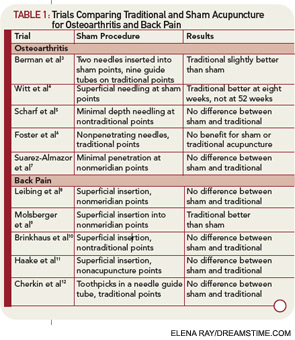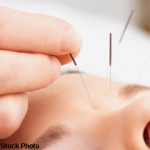Rheumatologists provide care for many patients with musculoskeletal pain and osteoarthritis (OA). Patients with these conditions accounted for 33.5% of visits to alternative therapists in 2007.1 Many of these visits were for acupuncture treatments to relieve pain. A National Health Statistics Report estimated that in 2007, there were 17,629 visits to acupuncturists at an out-of-pocket cost of more than $827 million.2 What benefits are patients receiving for their money?
This article will summarize the results of recent clinical trials of acupuncture for pain, discuss whether acupuncture analgesia is mediated by placebo effects, and consider how rheumatologists should advise patients about the use of acupuncture for relief of pain.
Clinical Trials
In traditional Chinese acupuncture (TCA), needles are inserted at specified points along meridians (see Figures 1 and 2), channels through which vital energy or qi is believed to flow. Specified groups of points are used to treat different disease conditions. Many older clinical trials reported that TCA provided more relief than usual treatment alone for musculoskeletal pain and OA. However, usual treatment alone is not an adequate control for the acupuncture procedure, and recent trials compared TCA with sham acupuncture procedures, in addition to usual treatment alone.
Table 1 lists trials that compared TCA, sham acupuncture, and usual treatment alone for knee OA and low back pain.3-12 A variety of sham procedures were used, including traditional and nontraditional acupuncture points, noninsertion or superficial insertion of needles, and contacting skin with a toothpick in a needle guide tube. Nine of the 10 trials found that TCA and sham treatments were more effective than usual care without acupuncture. One study found no benefit from the addition of TCA or sham acupuncture as an adjunct to exercise-based physiotherapy.6
A National Health Statistics Report estimated that in 2007 there were 17,629 visits to acupuncturists at an out-of-pocket cost of more than $827 million.
Two OA trials reported that the sham treatment was as effective as TCA.5,7 Berman et al reported that TCA was more effective than sham acupuncture.3 However, the same group concluded in a later review that the difference between TCA and sham acupuncture in their trial and others was small and clinically irrelevant.13 Witt et al observed that TCA was more effective than the sham procedure at eight weeks but not at 52 weeks.4 Four of the five back-pain studies found that TCA and sham acupuncture were equally effective.8,10-12 Data illustrating the equal efficacy of traditional and sham acupuncture for back pain are presented in Figure 3.12 Molsberger et al reported that TCA was more effective than sham acupuncture.9
Madsen et al performed a systematic review of trials of TCA and sham acupuncture for pain.14 The 13 trials they analyzed included five of the trials listed in Table 1 and other trials for headache, postoperative pain, and other conditions. They noted a small difference in efficacy between TCA and sham acupuncture, a moderate difference between sham and no acupuncture, and no association between the type of sham acupuncture and efficacy. There was substantial heterogeneity in the comparison of sham acupuncture with no acupuncture. Sham acupuncture was much more effective than usual care in some trials and no better in others. They concluded that the analgesic effect of acupuncture was small and seemed to lack clinical relevance, and that, “Whether needling at acupuncture points, or at any site, reduces pain independently of the psychological impact of the treatment ritual is unclear.”
A similar conclusion was reached by a systematic review of acupuncture for OA of the knee and hip.15 Twelve of the trials analyzed included only people with OA of the knee, three trials included only those with OA of the hip, and one trial included a mix of hip and knee OA. They concluded that “Sham-controlled trials show statistically significant benefits; however, these benefits are small, do not meet our predefined thresholds for clinical relevance, and are probably due at least partially to placebo effects from incomplete blinding.”
TABLE 2: Methodological Problems in Acupuncture Clinical Trials
- Variety of sham acupuncture procedures used
- Lack of randomization of patients to experimental groups
- Lack of blinding of patient allocation
- Failure to monitor acupuncturist–patient interactions
In addition to the absence of a sham acupuncture control, there are other methodological problems that complicate interpretation of acupuncture trials (see Table 2). Patient–provider interaction is an important variable in placebo-controlled trials.14,16 In the trial by Suarez-Amazor et al, acupuncturists were trained to interact with patients in a manner that conveyed high or neutral expectations of benefit from the treatment.7 Acupuncturists who conveyed high expectations had a small but statistically significant effect on patients’ pain reduction and satisfaction. Some traditional acupuncturists who participated in a trial that included sham acupuncture expressed discomfort with the perceived deception of patients.17 The acupuncturists’ discomfort may have unintentionally sent negative signals to patients. In most trials, there is no indication that patient–acupuncturist interactions were monitored. Other limitations of acupuncture trials include lack of randomization and inadequate concealment of allocation.18 Madsen et al reported that patient allocation was adequately concealed in only 8 of 13 trials.14 Another concern is the lack of information in some trials about the adequacy of blinding (i.e., whether patients were able to distinguish traditional from sham acupuncture).
TABLE 3: Issues to Consider When Counseling Patients About Acupuncture for Relief of Pain
- Current evidence suggests that acupuncture is a placebo treatment
- Efficacy: Approximately 50% of patients will experience relief of pain, and the magnitude of the relief is variable
- Adverse effects: Local adverse effects are usually minor, but acupuncturists may recommend potentially toxic herbal remedies
- Cost: A treatment course may cost $600–$1,200 and may not be covered by insurance
- Are the patient’s options for conventional treatment limited by comorbid health conditions?
In summary, the preponderance of current evidence indicates that TCA is no more effective than a variety of sham acupuncture procedures in relieving low back pain or knee pain caused by OA.
Is Acupuncture a Placebo Treatment?
The question of whether acupuncture analgesia is a placebo effect has to be considered in light of new knowledge of placebo effects and a reconceptualization of the meaning of placebo. The traditional definition of a placebo as a substance or treatment that is inert and lacks specific activity is inadequate to describe the complexity and variety of placebo effects.19-22 Placebo effects, such as the relief of pain, result from a number of factors, including conditioning and the expectations, beliefs, and desires of patients. A useful formulation of placebo effects, termed contextual healing, is, “that aspect of healing that is produced, activated, or enhanced by the context of the clinical encounter, as distinct from the specific efficacy of treatment interventions.”16 In that sense, placebo effects are an integral part of all encounters between patients and healthcare providers, and not merely deceptive practices. The mechanisms of placebo analgesia include activation of endogenous opioid and nonopioid control mechanisms, and alteration of central processing of pain.19,20
Expectation of benefit plays an important role in the efficacy of placebo treatments. A number of acupuncture trials revealed a correlation between patients’ pretrial expectations of benefit and outcomes.20,23-26 For example, in four trials of TCA and sham acupuncture for migraine, headache, chronic low back pain, and OA of the knee, patients were asked at baseline whether they considered acupuncture to be an effective treatment and what they expected from the treatment.24 Patients with high expectations had better outcomes (see Figure 4). Manipulation of pretreatment expectancy by investigators enhanced the analgesia produced by TCA and sham acupuncture.27 Although patients with high expectations exhibited comparable analgesia from TCA and sham acupuncture, TCA produced a greater functional magnetic resonance imaging (fMRI) signal decrease in pain-related brain regions.28
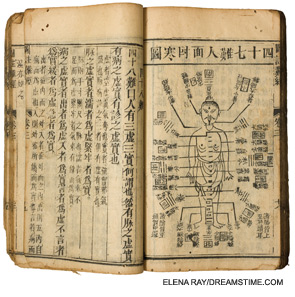
fMRI has been used to analyze changes in brain function associated with pain and its modulation. In a review of the neural correlates of acupuncture and placebos, Dhond et al noted that, “acupuncture modulates a widely distributed network of brain regions also involved in pain perception.”29 The networks modulated by placebos and acupuncture demonstrate overlap and some differences. A number of trials have used fMRI and positron emission tomography (PET) scanning to compare the effects of TCA and sham acupuncture on brain function.19-21,29 In general, there were similarities in the changes in signals produced by both types of procedures, such as decreased signals from pain-related brain regions, but there were also significant differences. The differences between trials may result from methodological problems, including heterogeneity of the populations studied (i.e., experimental pain and patients with chronic pain syndromes) and in the variety of sham acupuncture procedures employed.30 In addition, the reproducibility of acupuncture-induced fMRI patterns needs to be established. When Kong et al retested six subjects six times, they noted a relatively large variability between different sessions.31 Some studies also noted a lack of correlation between the magnitude of change in signals and the extent of relief from pain.32 In summary, although imaging techniques provide insights into the neurobiology of pain, at present these data allow no conclusions as to whether acupuncture analgesia is a placebo effect.
The efficacy of sham procedures has led some acupuncturists to suggest that because sham manipulations have physiologic effects, they are not placebos.33,34 The argument that any treatment producing physiologic effects is not a placebo is untenable because it ignores the vast literature concerning the physiological effects of placebos and mind–body interactions.19-22
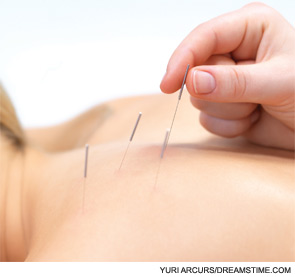
Is acupuncture analgesia a placebo effect? A definitive answer to that question awaits further elucidation of the mechanisms of acupuncture and placebo effects. Current evidence indicates that most of the benefits of acupuncture for pain syndromes result from the treatment ritual and patient–provider interaction, which meets the definition of a placebo effect.14-16,19,20,35
Counseling Patients
If relief of pain provided by acupuncture is a contextual or placebo effect, counseling patients requires consideration of the following issues: 1) How effective is the treatment? 2) What are its adverse effects? 3) How much does it cost? and 4) Is it ethical to recommend a placebo treatment without disclosure? (Table 3 summarizes some points to consider when counseling patients about acupuncture.)
With regard to efficacy, many trials express pain reduction data as means of the experimental groups and do not reveal what proportion of subjects had a positive response and whether the response was clinically meaningful. The data available indicate a positive response rate of 50% or less.4-7,10-12,14 The magnitude of analgesia has varied widely, from large to minimal, and it may be related to some aspects of the experimental protocol, such as whether the subjects were informed that they might receive placebo acupuncture.14 Most adverse events are minor, such as pain and bruising at the site of needle insertion, but the reporting of adverse events has not met the Consolidated Standards of Reporting Trials guidelines.36 Another safety consideration is that acupuncturists trained in traditional Chinese medicine frequently recommend the concomitant use of herbal medicines, which may expose patients to severe adverse events, such as aristolochic acid nephropathy.37-39 A course of acupuncture treatments is usually recommended, and at $50–$100 per treatment, the cost is appreciable.
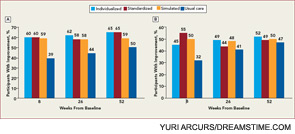
Recommendation of acupuncture without disclosure that it appears to be a placebo treatment violates ethical guidelines about deception of patients.40-42 Even with altruistic motivation, deception deprives the patient of full autonomy in making informed decisions about healthcare. It may also undermine trust in the physician and jeopardize future consultations and adherence to treatment recommendations.
Despite these ethical concerns, surveys have revealed that 50% or more of physicians in the United States, Denmark, and Israel frequently use placebos in practice.43-46 In one trial, 50% of the physicians were rheumatologists.43 In this context, the designation placebo means a treatment that is not considered to have a specific effect for the medical condition. The placebo treatments included over-the-counter analgesics, sedatives, vitamins, antibiotics for nonbacterial infections, and saline injections or infusions. The reasons for giving the treatment include placating patients and avoiding confrontations. The information given to patients included statements such as, “this is a substance that may help and will not hurt,” or “a medicine not typically used for your condition but might benefit you.” Fewer than 5% of physicians disclosed that the medicine was a placebo, and the use of placebos was considered ethically acceptable by a majority of physicians who used them.
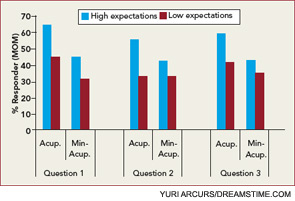
What advice should rheumatologists give to patients with OA of the knee concerning acupuncture treatments? After making sure that the patient understands the chronic nature of the problem, the benefits of conventional measures, especially nonpharmacologic modalities, in reducing pain and maintaining function should be emphasized strongly. Our enhanced knowledge of the power of patient–provider interactions should be used in a nondeceptive manner to convey to the patient our concern, sympathy, and expectations for improvement. In view of the chronic nature of OA, a likelihood of 50% or less that pain will be relieved, the limited duration of the relief, the cost of treatment, and ethical considerations, I would not recommend acupuncture as an adjunctive treatment.
If the patient inquires about acupuncture, I would respond that the conventional measures of known efficacy should be tried first. However, ethical concerns should be tempered by consideration of the individual’s situation. The patient’s medical condition may limit the feasibility of conventional measures, or she or he may derive limited relief from them. In those circumstances, if the patient wants to try acupuncture, I would not argue against it. I would say that it seems to help some people, and I would not destroy the potential benefit of the procedure by stating that it is a placebo. In her discussion of the ethics of the placebo in medical practice, Bok cites the recommendation of Bishop Taylor, a 17th-century British cleric, to “lie like a doctor” when doing so can help patients.40 I share Bok’s concern about “benevolent deceit” of patients, but sometimes that is all we have to offer.
Dr. Marcus is a professor of medicine and immunology emeritus at the Baylor College of Medicine in Houston.
References
- Barnes PM, Bloom B, Nahin RL. Complementary and alternative medicine use among adults and children: United States, 2007. Natl Health Stat Report. 2008 Dec 10;1-23.
- Nahin RL, Barnes PM, Stussman BJ, Bloom B. Costs of complementary and alternative medicine (CAM) and frequency of visits to CAM practitioners: United States, 2007. Natl Health Stat Report. 2009 July 30;1-14.
- Berman BM, Lao L, Langenberg P, Lee WL, Gilpin AM, Hochberg MC. Effectiveness of acupuncture as adjunctive therapy in osteoarthritis of the knee: A randomized, controlled trial. Ann Intern Med. 2004;141:901-910.
- Witt CM, Jena S, Brinkhaus B, Liecker B, Wegscheider K, Willich SN. Acupuncture in patients with osteoarthritis of the knee or hip: A randomized, controlled trial with an additional nonrandomized arm. Arthritis Rheum. 2006; 54:3485-3493.
- Scharf HP, Mansmann U, Streitberger K, et al. Acupuncture and knee osteoarthritis: A three-armed randomized trial. Ann Intern Med. 2006;145:12-20.
- Foster NE, Thomas E, Barlas P, et al. Acupuncture as an adjunct to exercise based physiotherapy for osteoarthritis of the knee: Randomised controlled trial. BMJ. 2007;335:436.
- Suarez-Almazor ME, Looney C, Liu Y, et al. A randomized controlled trial of acupuncture for osteoarthritis of the knee: Effects of patient-provider communication. Arthritis Care Res. 2010:62:1229-1236.
- Leibing E, Leonhardt U, Koster G, et al. Acupuncture treatment of chronic low-back pain—a randomized, blinded, placebo-controlled trial with 9-month follow-up. Pain. 2002;96:189-196.
- Molsberger AF, Mau J, Pawelec DB, Winkler J. Does acupuncture improve the orthopedic management of chronic low back pain—a randomized, blinded, controlled trial with 3 months follow up. Pain. 2002;99:579-587.
- Brinkhaus B, Witt CM, Jena S, et al. Acupuncture in patients with chronic low back pain. Arch Int Med. 2006;166:450-457.
- Haake M, Muller H-H, Schade-Brittinger C, et al. German acupuncture trials (GERAC) for chronic low back pain. Arch Int Med. 2007;167:1892-1898.
- Cherkin DC, Sherman KJ, Avins AL, et al. A randomized trial comparing acupuncture, simulated acupuncture and usual care for chronic low back pain. Arch Intern Med. 2009;169:858-866.
- Manheimer E, Linde K, Lao L, Bouter LM, Berman BM. Meta-analysis: Acupuncture for osteoarthritis of the knee. Ann Int Med. 2007;146:868-877.
- Madsen MV, Gøtzsche PC, Hrobjartsson A. Acupuncture treatment for pain: Systematic review of randomised clinical trials with acupuncture, placebo acupuncture, and no acupuncture groups. BMJ. 2009;338:a3115.
- Manheimer E, Cheng K, Linde K, et al. Acupuncture for peripheral joint osteoarthritis. Cochrane Database Syst Rev. 2010 Jan 20:CD001977.
- Miller FG, Kaptchuk TJ. The power of context: Reconceptualizing the placebo effect. J R Soc Med. 2008;101:222-225.
- McManus CA, Kaptchuk TJ, Schnyer DN, et al. Experiences of acupuncturists in a placebo-controlled randomized clinical trial. J Altern Complement Med. 2007:5:533-537.
- Manheimer E, Ezzo J, Hadhazy V, Berman B. Published reports of acupuncture trials showed important limitations. J Clin Epidemiol. 2006;59:107-113.
- Price DD, Finniss DG, Benedetti F. A comprehensive review of the placebo effect: Recent advances and current thought. Annu Rev Psychol. 2008; 59:565-590.
- Finniss DG, Kaptchuk TJ, Miller F, Benedetti F. Biological, clinical and ethical advances of placebo effects. Lancet. 2010;375:686-695.
- Benedetti F, Mayberg HS, Wager TD, Stohler CS, Zubieta J-K. Neurobiological mechanisms of the placebo effect. J Neuroscience. 2005;25:10390-10402.
- Benedetti F. Mechanisms of placebo and placebo-related effects across diseases and treatments. Annu Rev Pharmacol Toxicol. 2008;48:33-60.
- Pariente J, White P, Frackowiak RS, Lewith G. Expectancy and belief modulate the neuronal substrates of pain treated by acupuncture. Neuroimage. 2005;25:1161-1167.
- Linde K, Witt CM, Streng A, et al. The impact of patient expectations on outcomes in four randomized controlled trials of acupuncture in patients with chronic pain. Pain. 2007;128:264-271.
- Bausell RB, Lao L, Bergman S, Lee WL, Berman BM. Is acupuncture analgesia an expectancy effect? Preliminary evidence based on participants’ perceived assignments in two placebo-controlled trials. Eval Health Prof. 2005;28:9-26.
- Benedetti F. What do you expect from this treatment? Changing our mind about clinical trials. Pain. 2007;128:193-194.
- Myers SS, Phillips RS, Davis RB, et al. Patient expectations as predictors of outcome in patients with acute low back pain. J Gen Intern Med. 2008; 23:148-153.
- Kong J, Kaptchuk TJ, Polich G, et al. An fMRI study on the interaction and dissociation between expectation of pain relief and acupuncture treatment. Neuroimage. 2009;47:1066-1076.
- Dhond RP, Kettner N, Napadow V. Do the neural correlates of acupuncture and placebo effects differ? Pain. 2007; 128:8-12.
- Beissner F, Henke C. Methodological problems in fMRI studies on acupuncture: A critical review with special emphasis on visual and auditory cortex activations. Evid Based Complement Alternat Med. 2009 Sept 30 [Epub ahead of print].
- Kong J, Gollub RL, Webb JM, Kong J-T, Vangel MG, Kwong K. Test-retest study of fMRI signal change evoked by electroacupuncture stimulation. Neuroimage. 2007;34:1171-1181.
- Kong J, Kaptchuk TJ, Polich G, et al. Expectancy and treatment interactions: A dissociation between acupuncture analgesia and expectancy evoked placebo analgesia. Neuroimage. 2009;45:940-949.
- Lundeberg T, Lund I, Näslund NJ, Thomas M. The Emperors sham—wrong assumptions that sham needling is a sham. Acupunct Med. 2008;26:239-242.
- Wayne, PM, Hammerschlag R, Langevin HM, Napadow V, Park JJ, Schnyer RN. Resolving paradoxes in acupuncture research: A roundtable discussion. J Altern Complement Med. 2009; 15:1039-1044.
- O’Connell NE, Wand BM, Goldacre B. Interpretive bias in acupuncture research? A case study. Eval Health Prof. 2009;32:393-409.
- Capili B, Anastasi JK, Geiger JN. Adverse event reporting in acupuncture trials focusing on pain. Clin J Pain. 2010; 26:43-48.
- Nortier JL, Martinez MM, Schmeiser HH, et al. (2000) Urothelial carcinoma associated with the use of a Chinese herb (Aristolochia fangchi). N Engl J Med. 2000;342:1686-1692.
- Meyer MM, Chen T-P, Bennett WM. Chinese herb nephropathy. Baylor University Medical Center Proc. 2000;13:334-337.
- Cosyns JP. Aristolochic acid and “Chinese herbs nephropathy”: A review of the evidence to date. Drug Saf. 2003;26:33-48.
- Bok S. Ethical issues in use of placebo in medical practice and clinical trials. In: Guess HA, Kleinman A, Kusek JW, Engel LW. The Science of the Placebo. Toward an Interdisciplinary Research Agenda. London: BMJ Books; 2002:53-74.
- Bostick NA, Sade R, Levine MA, et al. Placebo Use in Clinical Practice: Report of the American Medical Association Council on Ethical and Judicial Affairs. J Clin Ethics. 2008;19:58-61.
- Price DD. New facts and improved ethical guidelines for placebo analgesia. J Pain. 2005;6:213-214.
- Sherman R, Hickner J. Academic physicians use placebos in clinical practice and believe in the mind-body connection. J Gen Int Med. 2008;23;7-10.
- Hróbjartsson A, Norup M. The use of placebo interventions in medical practice – a national questionnaire and survey of Danish clinicians. Eval Health Prof. 2003;26:153-165.
- Tilburt JC, Emanuel EJ, Kaptchuk TJ, Curtin FA, Miller FG. Prescribing “placebo treatments”: Results of a national survey of US internists and rheumatologists. BMJ. 2008; 337:a1938.
- Nitzan U, Lichtenberg P. Questionnaire survey on use of the placebo. BMJ. 2004; 320:944-946.
